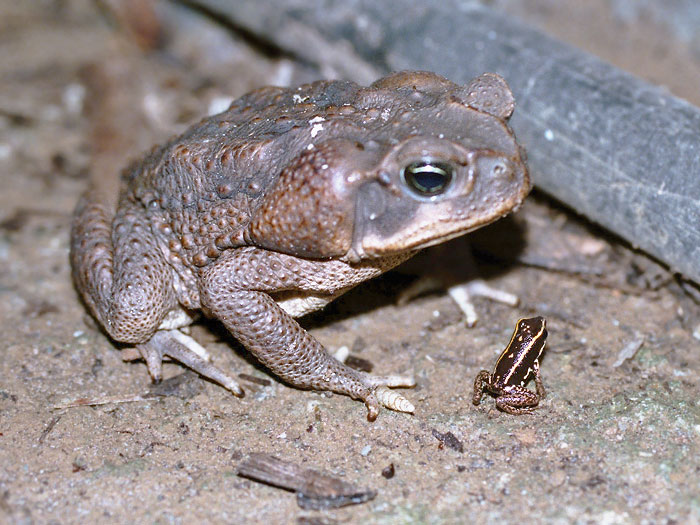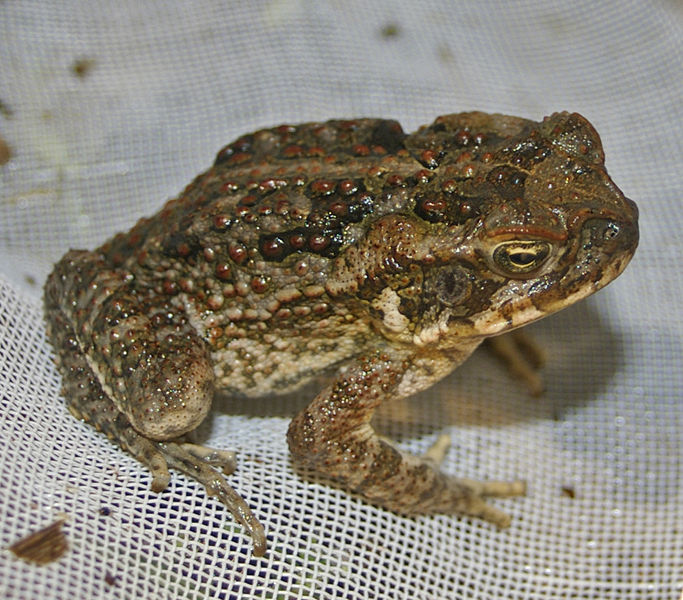The Most-Traveled Cane Toad
Lifecycle: To be a big bad toad...
 After being deposited on a substrate, the
8,000-35,000 eggs swell to about 3mm and hatch in about 3-4
days. Their first food source is jelly of the
eggs, but the tadpoles then transition to eating algae, and
finally will eat both vegetation and other tadpoles (both their
own species and other species). The duration
of the tadpole stage is dependent upon available nutrients, and
can range from just over 2 weeks to 6 months.
The tadpole attains a length of 1-3 cm, with its
After being deposited on a substrate, the
8,000-35,000 eggs swell to about 3mm and hatch in about 3-4
days. Their first food source is jelly of the
eggs, but the tadpoles then transition to eating algae, and
finally will eat both vegetation and other tadpoles (both their
own species and other species). The duration
of the tadpole stage is dependent upon available nutrients, and
can range from just over 2 weeks to 6 months.
The tadpole attains a length of 1-3 cm, with its tail in equal
length to its body. It is advantageous for
tadpoles to develop quickly, as watering holes can dry up
–resulting in the death of any tadpoles. Warm
water temperatures result in more rapid tadpole growth and
maturation. The typical tadpole begins
maturation (sprouting first back legs, then front legs, and
attaining a slightly greenish color) around 1-2 months of age
and is then known as a metamorph.
tail in equal
length to its body. It is advantageous for
tadpoles to develop quickly, as watering holes can dry up
–resulting in the death of any tadpoles. Warm
water temperatures result in more rapid tadpole growth and
maturation. The typical tadpole begins
maturation (sprouting first back legs, then front legs, and
attaining a slightly greenish color) around 1-2 months of age
and is then known as a metamorph.
Of a clutch of 8,000 eggs, between 20-800 of them will survive to the metamorph stage nown as snout to vent, or SV), metamorphs are only 11 mm
and
weigh only 0.01% of what they’ll likely weigh as adults.
This exceptionally small size also contributes to
mortality, yet the risks of small metamorph size must be
balanced against the risk of dying if the tadpole stage is
prolonged so as to emerge a bigger toadlet. The metamorph is also losing the
toxicity that it has had its entire life (as egg then tadpole)
and hasn’t yet accumulated a store of adult toxin.
The “learning curve” of
coordination, the need to adapt to life
outside the water, and a lack of toxicity contribute to
the metamorph stage being most vulnerable time for a cane toad.
The metamorphs stay huddled along the
waterhole.
nown as snout to vent, or SV), metamorphs are only 11 mm
and
weigh only 0.01% of what they’ll likely weigh as adults.
This exceptionally small size also contributes to
mortality, yet the risks of small metamorph size must be
balanced against the risk of dying if the tadpole stage is
prolonged so as to emerge a bigger toadlet. The metamorph is also losing the
toxicity that it has had its entire life (as egg then tadpole)
and hasn’t yet accumulated a store of adult toxin.
The “learning curve” of
coordination, the need to adapt to life
outside the water, and a lack of toxicity contribute to
the metamorph stage being most vulnerable time for a cane toad.
The metamorphs stay huddled along the
waterhole.
Within several days, the little toads will begin migrating away from the pond, likely in part due to the high competition for prey that results from the high concentration of toadlets, but also to escape the adult toads who camp near the watering holes and will eat the smaller toads. The toadlets will not return to the breeding site until they are sexually mature, which generally occurs within 1-2 years, depending upon conditions and the climate. A toad generally reaches sexual maturity between 75-100 mm, and with sexual maturity are more brown to black in color. The toad may live around 10 years. The most growth occurs during the annual wet season, with toads growing about 2.5 cm/year after the second year until attaining full size. Adults often attain lengths of 10-15 cm, with females being larger than males.
 To
be a big bad cane toad! Every tadpole's dream.
To
be a big bad cane toad! Every tadpole's dream.
Cane toads amass more toxin as they get bigger. Next, read about their poisons! This is a toady dream come true!